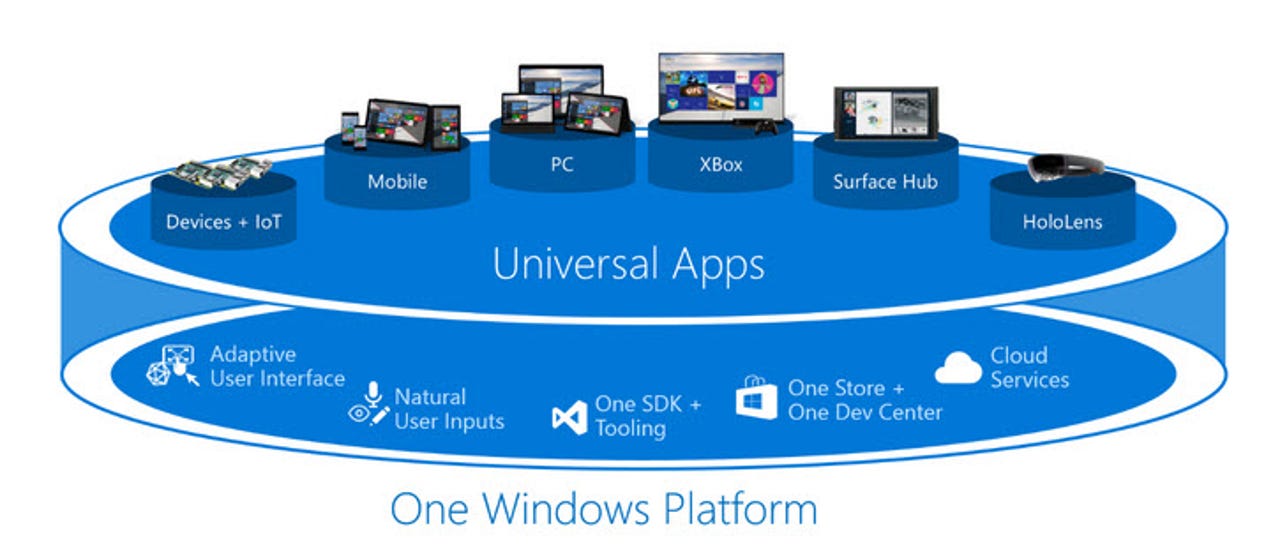Microsoft's new Windows 10 Universal App Platform: A 'superset of WinRT'

Microsoft officials went public with some new details about its strategy for enabling developers to write once and run on any version of Windows during a deep-dive session at Mobile World Congress on March 2.

For the last few years, Microsoft officials have been evangelizing the idea that "One Windows" running across a variety of device types will enable developers to create universal apps that will build on a single runtime, use an increasingly similar set of application programming interfaces (APIs) and developer tools and be available from a single store.
With Windows 8 and Windows Phone 8, Microsoft got a step closer to realizing its "One Windows" vision. But with Windows 10, the company is hoping to get a lot closer to this promised nirvana.
The new universal app platform (UAP) that Microsoft is building with Windows 10 will sit on top of the Windows core. The UAP is a superset of WinRT, the Windows 8 and Windows RT runtime, according to tweets from Matt Lacey (@mrlacey), who runs the Windows Apps London developer group.
"The migration path to Windows 10 UAP apps is from 'universal' 8.1 apps," Lacey tweeted. There are some "additional conversion steps" needed, ranging from referencing extension development kits, to moving Charms bar interactions. (Here's a list of six steps provided by Microsoft.)
Developers will be able to target different versions -- either a range or individual -- of the UAP, not the underlying version of Windows, according to Lacey. The UAP "is a versioned collection of versioned contracts," he explained.
Universal apps don't mean apps that look and work exactly the same across all device types. Microsoft is building "extension SDKs (software development kits) that will allow developers to build platform/device-specific elements while still building on top of a single binary, according to tweets from the event.
The Adaptive User Interface in universal apps will adapt to the device, tweeted freelance tech journalist Tim Anderson (@timanderson). This Adaptive UX is a set of adaptive controls that support mouse, keyboard and touch, and "look a bit different from Metro," Anderson said.
Microsoft also is opening up Windows 10 across platforms to a new category of applications officials are calling "hosted web apps," or simply "Web apps." These are wrapped versions of Web sites that will be available for download from the coming single store. These apps also will be able to call universal APIs like notifications, camera, contact list and calendar from JavaScript. Microsoft is making these hosted Web apps pinnable and able to be integrated with Cortana, Microsoft's personal digital assistant.
It's worth noting that Microsoft execs still have not confirmed a report in a (now-removed) Microsoft blog post that Win32 apps, along with other digital content, also will be available in the coming single store.
During today's session for developers, Microsoft officials said that a first public build of Project Spartan -- Microsoft's new lightweight browser for Windows 10 and Windows 10 mobile -- will be available as part of the next preview build of Windows 10. Microsoft officials confirmed today that Spartan will be a universal Windows Store app that will be downloadable from the unified Windows Store.
Microsoft officials were hoping to deliver a new preview test build of Windows 10 roughly every month. There was no February test build of Windows 10 for desktops, but a new one is expected some time in the coming weeks, as is one for Windows Phones.